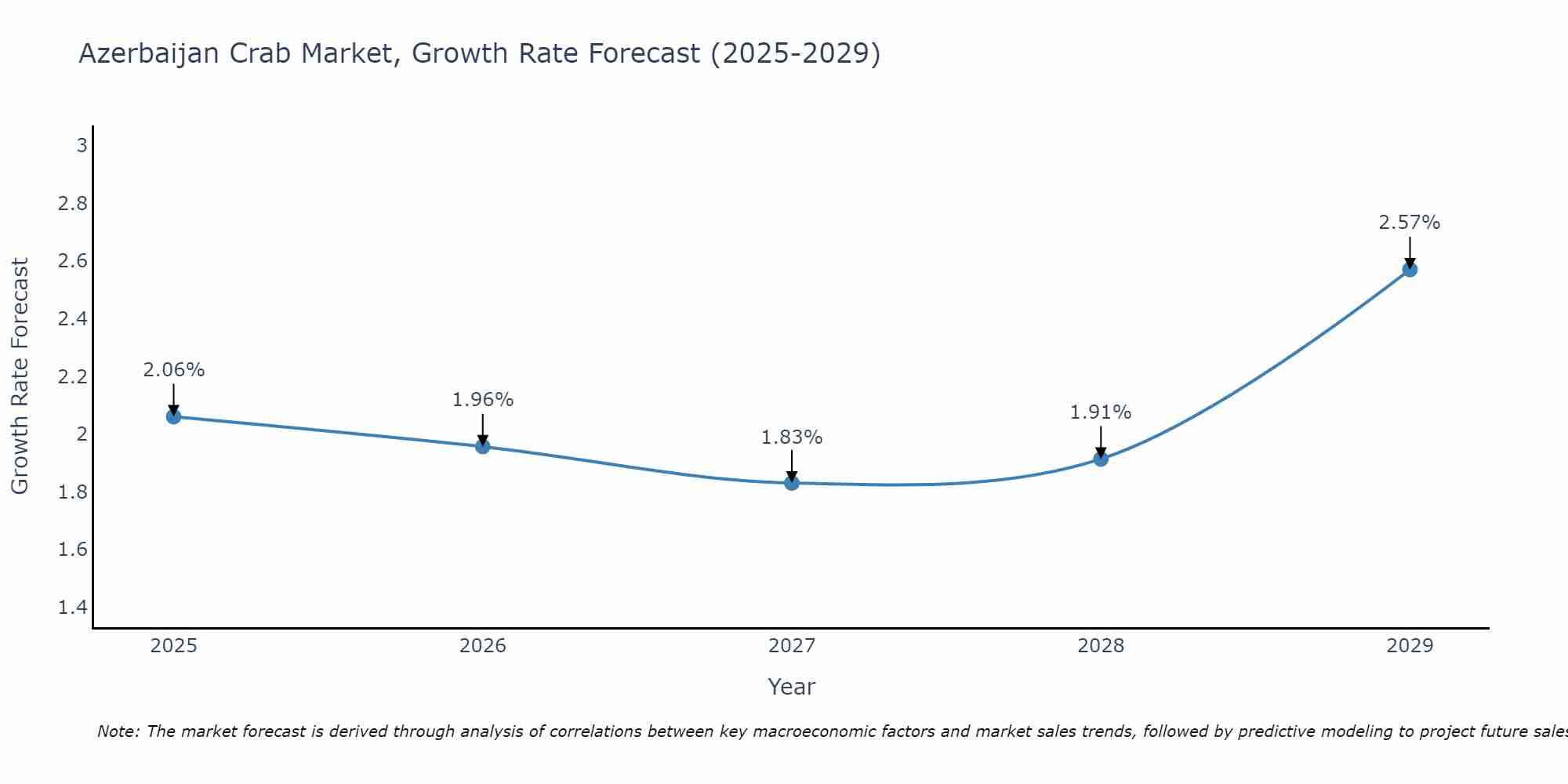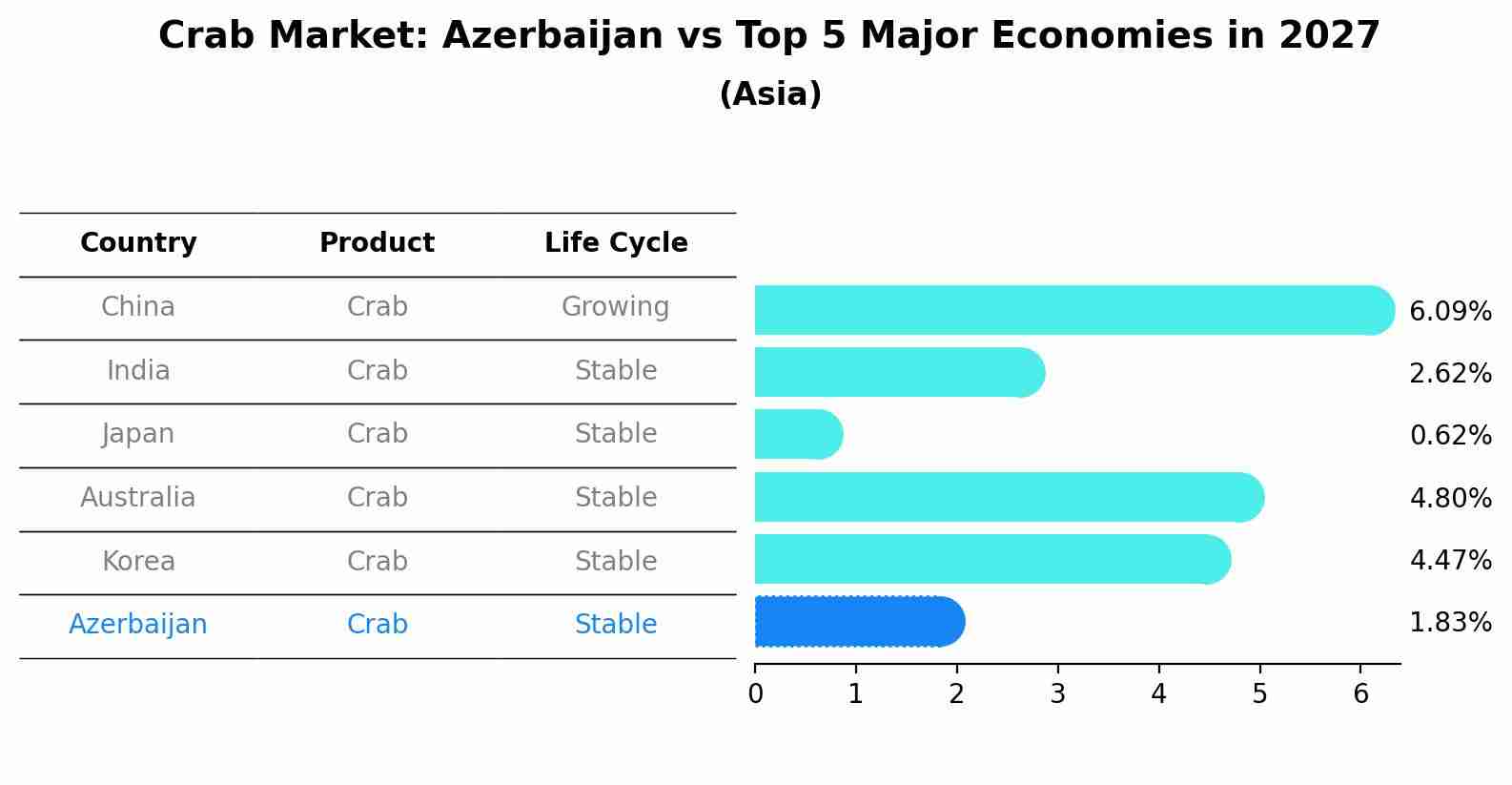Azerbaijan Crab Market (2025-2031) Outlook | Size, Value, Industry, Companies, Growth, Share, Revenue, Forecast, Analysis & Trends
| Product Code: ETC088876 | Publication Date: Jun 2021 | Updated Date: Jun 2025 | Product Type: Report | |
| Publisher: 6Wresearch | Author: Sachin Kumar Rai | No. of Pages: 70 | No. of Figures: 35 | No. of Tables: 5 |
Azerbaijan Crab Market Size Growth Rate
The Azerbaijan Crab Market is projected to witness mixed growth rate patterns during 2025 to 2029. The growth rate starts at 2.06% in 2025 and reaches 2.57% by 2029.

Crab Market: Azerbaijan vs Top 5 Major Economies in 2027 (Asia)
The Crab market in Azerbaijan is projected to grow at a stable growth rate of 1.83% by 2027, within the Asia region led by China, along with other countries like India, Japan, Australia and South Korea, collectively shaping a dynamic and evolving market environment driven by innovation and increasing adoption of emerging technologies.

Azerbaijan Crab Market Overview
The Azerbaijan crab market is primarily dominated by the Caspian Sea crab species, with the most common being the Caspian Sea brown crab. The market is driven by both domestic consumption and export demand, with Russia and other neighboring countries being key export markets. The crab industry in Azerbaijan faces challenges related to sustainability and overfishing, leading to government regulations and initiatives to manage crab stocks effectively. The market also experiences competition from imported crab products from other countries. Despite these challenges, the Azerbaijan crab market shows potential for growth, especially as consumers continue to seek out high-quality seafood products. Additionally, the rise of tourism in Azerbaijan has increased demand for local seafood delicacies, including crab dishes, further driving market opportunities.
Azerbaijan Crab Market Trends
The Azerbaijan Crab Market is experiencing a growing demand for crab products due to the increasing popularity of seafood consumption among the local population. Consumers are becoming more interested in trying different types of crab dishes, leading to a surge in sales of both fresh and processed crab products. Additionally, there is a trend towards sustainable and environmentally friendly sourcing practices in the market, with consumers showing a preference for crab products that are harvested using responsible fishing methods. As a result, suppliers in the Azerbaijan Crab Market are focusing on promoting their sustainable sourcing practices and high-quality products to meet the evolving preferences of consumers and capitalize on this growing trend.
Azerbaijan Crab Market Challenges
In the Azerbaijan Crab Market, one of the main challenges faced is competition from imported crabs, which often leads to pricing pressures for local producers. Additionally, there are issues related to overfishing and sustainability concerns, as some crab species are being harvested at unsustainable levels. Limited access to modern technology and infrastructure for crab farming and processing also hinders the industry`s growth and efficiency. Furthermore, the lack of standardized quality control measures and certification systems can impact the market`s reputation and export potential. Addressing these challenges will require collaborations between government agencies, industry stakeholders, and environmental organizations to promote sustainable practices, improve infrastructure, and enhance market competitiveness.
Azerbaijan Crab Market Investment Opportunities
The Azerbaijan Crab Market presents various investment opportunities for potential investors. With the increasing demand for seafood products in the region, investing in crab farming and processing facilities can be lucrative. Additionally, there is a growing trend of export opportunities for Azerbaijan crab products to international markets, further expanding the potential for profit. Investing in technology and infrastructure improvements within the industry can also lead to increased efficiency and productivity. Furthermore, there is potential for innovation in value-added products such as crab meat processing and packaging. Overall, the Azerbaijan Crab Market offers a range of investment avenues for those looking to capitalize on the growing demand for crab products both domestically and internationally.
Azerbaijan Crab Market Government Policy
The Azerbaijan government has implemented policies to regulate the crab market, aiming to protect the sustainability of crab populations and ensure fair competition among market players. These policies include setting catch limits and seasons, requiring licensing for crab fishing activities, and enforcing penalties for illegal fishing practices. Additionally, the government has established initiatives to promote the development of the crab industry through investments in infrastructure, technology, and research. Overall, these policies are designed to balance economic interests with environmental conservation efforts in the Azerbaijan crab market.
Azerbaijan Crab Market Future Outlook
The future outlook for the Azerbaijan Crab Market appears to be promising due to several factors. Increasing consumer demand for seafood products, coupled with the growing popularity of crab dishes globally, is expected to drive market growth. Additionally, advancements in aquaculture techniques and technologies are likely to improve crab farming efficiency and production capacity in Azerbaijan. The country`s strategic location along the Caspian Sea provides a natural advantage for crab harvesting and export opportunities. However, challenges such as environmental sustainability, regulatory compliance, and competition from other seafood markets may impact the market`s growth trajectory. Overall, with the right investments in infrastructure and sustainability practices, the Azerbaijan Crab Market has the potential to expand and thrive in the coming years.
Key Highlights of the Report:
- Azerbaijan Crab Market Outlook
- Market Size of Azerbaijan Crab Market, 2021
- Forecast of Azerbaijan Crab Market, 2031
- Historical Data and Forecast of Azerbaijan Crab Revenues & Volume for the Period 2021 - 2031
- Azerbaijan Crab Market Trend Evolution
- Azerbaijan Crab Market Drivers and Challenges
- Azerbaijan Crab Price Trends
- Azerbaijan Crab Porter's Five Forces
- Azerbaijan Crab Industry Life Cycle
- Historical Data and Forecast of Azerbaijan Crab Market Revenues & Volume By Type for the Period 2021 - 2031
- Historical Data and Forecast of Azerbaijan Crab Market Revenues & Volume By Blue Crab for the Period 2021 - 2031
- Historical Data and Forecast of Azerbaijan Crab Market Revenues & Volume By Chinese Mitten Crab for the Period 2021 - 2031
- Historical Data and Forecast of Azerbaijan Crab Market Revenues & Volume By Gazami Crab for the Period 2021 - 2031
- Historical Data and Forecast of Azerbaijan Crab Market Revenues & Volume By Others for the Period 2021 - 2031
- Historical Data and Forecast of Azerbaijan Crab Market Revenues & Volume By Form for the Period 2021 - 2031
- Historical Data and Forecast of Azerbaijan Crab Market Revenues & Volume By Frozen for the Period 2021 - 2031
- Historical Data and Forecast of Azerbaijan Crab Market Revenues & Volume By Canned for the Period 2021 - 2031
- Historical Data and Forecast of Azerbaijan Crab Market Revenues & Volume By Others for the Period 2021 - 2031
- Azerbaijan Crab Import Export Trade Statistics
- Market Opportunity Assessment By Type
- Market Opportunity Assessment By Form
- Azerbaijan Crab Top Companies Market Share
- Azerbaijan Crab Competitive Benchmarking By Technical and Operational Parameters
- Azerbaijan Crab Company Profiles
- Azerbaijan Crab Key Strategic Recommendations
Frequently Asked Questions About the Market Study (FAQs):
1 Executive Summary |
2 Introduction |
2.1 Key Highlights of the Report |
2.2 Report Description |
2.3 Market Scope & Segmentation |
2.4 Research Methodology |
2.5 Assumptions |
3 Azerbaijan Crab Market Overview |
3.1 Azerbaijan Country Macro Economic Indicators |
3.2 Azerbaijan Crab Market Revenues & Volume, 2021 & 2031F |
3.3 Azerbaijan Crab Market - Industry Life Cycle |
3.4 Azerbaijan Crab Market - Porter's Five Forces |
3.5 Azerbaijan Crab Market Revenues & Volume Share, By Type, 2021 & 2031F |
3.6 Azerbaijan Crab Market Revenues & Volume Share, By Form, 2021 & 2031F |
4 Azerbaijan Crab Market Dynamics |
4.1 Impact Analysis |
4.2 Market Drivers |
4.3 Market Restraints |
5 Azerbaijan Crab Market Trends |
6 Azerbaijan Crab Market, By Types |
6.1 Azerbaijan Crab Market, By Type |
6.1.1 Overview and Analysis |
6.1.2 Azerbaijan Crab Market Revenues & Volume, By Type, 2018 - 2027F |
6.1.3 Azerbaijan Crab Market Revenues & Volume, By Blue Crab, 2018 - 2027F |
6.1.4 Azerbaijan Crab Market Revenues & Volume, By Chinese Mitten Crab, 2018 - 2027F |
6.1.5 Azerbaijan Crab Market Revenues & Volume, By Gazami Crab, 2018 - 2027F |
6.1.6 Azerbaijan Crab Market Revenues & Volume, By Others, 2018 - 2027F |
6.2 Azerbaijan Crab Market, By Form |
6.2.1 Overview and Analysis |
6.2.2 Azerbaijan Crab Market Revenues & Volume, By Frozen, 2018 - 2027F |
6.2.3 Azerbaijan Crab Market Revenues & Volume, By Canned, 2018 - 2027F |
6.2.4 Azerbaijan Crab Market Revenues & Volume, By Others, 2018 - 2027F |
7 Azerbaijan Crab Market Import-Export Trade Statistics |
7.1 Azerbaijan Crab Market Export to Major Countries |
7.2 Azerbaijan Crab Market Imports from Major Countries |
8 Azerbaijan Crab Market Key Performance Indicators |
9 Azerbaijan Crab Market - Opportunity Assessment |
9.1 Azerbaijan Crab Market Opportunity Assessment, By Type, 2021 & 2031F |
9.2 Azerbaijan Crab Market Opportunity Assessment, By Form, 2021 & 2031F |
10 Azerbaijan Crab Market - Competitive Landscape |
10.1 Azerbaijan Crab Market Revenue Share, By Companies, 2021 |
10.2 Azerbaijan Crab Market Competitive Benchmarking, By Operating and Technical Parameters |
11 Company Profiles |
12 Recommendations |
13 Disclaimer |
- Single User License$ 1,995
- Department License$ 2,400
- Site License$ 3,120
- Global License$ 3,795
Search
Thought Leadership and Analyst Meet
Our Clients
Related Reports
- Afghanistan Apparel Market (2026-2032) | Growth, Outlook, Industry, Segmentation, Forecast, Size, Companies, Trends, Value, Share, Analysis & Revenue
- Canada Oil and Gas Market (2026-2032) | Share, Segmentation, Value, Industry, Trends, Forecast, Analysis, Size & Revenue, Growth, Competitive Landscape, Outlook, Companies
- Germany Breakfast Food Market (2026-2032) | Industry, Share, Growth, Size, Companies, Value, Analysis, Revenue, Trends, Forecast & Outlook
- Australia Briquette Market (2025-2031) | Growth, Size, Revenue, Forecast, Analysis, Trends, Value, Share, Industry & Companies
- Vietnam System Integrator Market (2025-2031) | Size, Companies, Analysis, Industry, Value, Forecast, Growth, Trends, Revenue & Share
- ASEAN and Thailand Brain Health Supplements Market (2025-2031) | Strategy, Consumer Insights, Analysis, Investment Trends, Opportunities, Growth, Size, Share, Industry, Revenue, Segments, Value, Segmentation, Supply, Forecast, Restraints, Outlook, Competition, Drivers, Trends, Demand, Pricing Analysis, Competitive, Strategic Insights, Companies, Challenges
- ASEAN Bearings Market (2025-2031) | Strategy, Consumer Insights, Analysis, Investment Trends, Opportunities, Growth, Size, Share, Industry, Revenue, Segments, Value, Segmentation, Supply, Forecast, Restraints, Outlook, Competition, Drivers, Trends, Demand, Pricing Analysis, Competitive, Strategic Insights, Companies, Challenges
- Europe Flooring Market (2025-2031) | Outlook, Share, Industry, Trends, Forecast, Companies, Revenue, Size, Analysis, Growth & Value
- Saudi Arabia Manlift Market (2025-2031) | Outlook, Size, Growth, Trends, Companies, Industry, Revenue, Value, Share, Forecast & Analysis
- Uganda Excavator, Crane, and Wheel Loaders Market (2025-2031) | Strategy, Consumer Insights, Analysis, Investment Trends, Opportunities, Growth, Size, Share, Industry, Revenue, Segments, Value, Segmentation, Supply, Forecast, Restraints, Outlook, Competition, Drivers, Trends, Demand, Pricing Analysis, Competitive, Strategic Insights, Companies, Challenges
Industry Events and Analyst Meet
Whitepaper
- Middle East & Africa Commercial Security Market Click here to view more.
- Middle East & Africa Fire Safety Systems & Equipment Market Click here to view more.
- GCC Drone Market Click here to view more.
- Middle East Lighting Fixture Market Click here to view more.
- GCC Physical & Perimeter Security Market Click here to view more.
6WResearch In News
- Doha a strategic location for EV manufacturing hub: IPA Qatar
- Demand for luxury TVs surging in the GCC, says Samsung
- Empowering Growth: The Thriving Journey of Bangladesh’s Cable Industry
- Demand for luxury TVs surging in the GCC, says Samsung
- Video call with a traditional healer? Once unthinkable, it’s now common in South Africa
- Intelligent Buildings To Smooth GCC’s Path To Net Zero


















